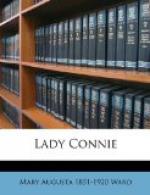On the pianola, or what preceded it—then as now—the player provided his own rendering. But the Orpheus, the precursor also of types that have since been greatly perfected, was played by an electrical mechanism, and the audience was intended to listen to Chopin or Beethoven, to Schumann or Brahms, as interpreted by the famous players of the moment, without any intervening personality.
These things are very familiar to our generation. In the eighties, they were only a vision and a possibility, and Falloden’s lavish expenditure was in fact stimulating one of the first inventors.
But Connie also was playing an important part. Both Lord and Lady Risborough had possessed devoted friends in Paris, and Connie had made others of her own among the young folk with whom she had danced and flirted and talked during a happy spring with her parents in the Avenue Marceau. She had set these playfellows of hers to work, and with most brilliant success. Otto’s story, as told by her vivacious letters, had gone the round. No woman of twice her age could have told it more adroitly. Otto appeared as the victim of an unfortunate accident in a college frolic; Falloden as the guardian friend; herself, as his lieutenant. It touched the romantic sense, the generous heart of musical Paris. There were many who remembered Otto’s father and mother and the musical promise of the bright-haired boy. The Polish colony in Paris, a survival from the tragic days of Poland’s exodus under the revolutionary skies of the thirties and the sixties, had been appealed to, and both Polish and French musicians were already in communication with Chaumart, and producing records under his direction. The young Polish marvel of the day—Paderewski—had been drawn in, and his renderings of Chopin’s finest work were to provide the bulk of the rolls. Connie’s dear old Polish teacher, himself a composer, was at work on a grouping of folk-songs from Poland and Lithuania—the most characteristic utterance of a martyred people.
“They are songs, chere petite,” wrote the old man—“of revolt, of exile, and of death. There is no other folk-song like them in the world, just as there is no history in the world like Poland’s. Your poor friend knows them all—has known them all from his childhood. They will speak to him of his torn country. He will hear in them the cry of the White Eagle—the White Eagle of Poland—as she soars wounded and bleeding over the southern plains, or sinks dying into the marshes and forests of Lithuania. It is in these songs that we Poles listen to the very heart-beats of our outraged country. Our songs—our music—our poets—our memories:—as a nation that is all we have—except the faith in us that never dies. Hinc surrectura! Yes, she shall rise again, our Poland! Our hope is in God, and in the human heart, the human conscience, that He has made. Comfort your friend. He has lost much, poor boy!—but he has still ears to hear, a brain, an imagination to conceive. Let him work still for music and for Poland—they will some day reward him!”




